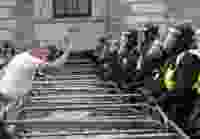
The case for a British civil defence reserve
The need to plan for potential future societal disruption means drawing up plans for a civil defence reserve to assist police and military forces in maintaining law and order, writes Ken Crawford.
It is right that politicians should set an optimistic and aspirational vision for the future, even more so given the recent political upheavals. However, care must also be taken to adequately prepare for negative shock events such as terror attacks with nuclear, chemical or biological material.
Japan is the only nation to contend with a nuclear attack, two 15 KT A-bombs dropped by air over Hiroshima and Nagasaki in 1945. Contemporary strategic nuclear weapons deliver a far greater yield (1000+ KT) and threaten a scale of destruction so great it cannot realistically be planned for if multiple cities are hit in a small nation like Britain. However, a terrorist attack involving so-called 'portable' nukes in the 1-10 KT range would destroy what the American's call a 'city block', more at the higher yield, creating a practical and psychological disaster for the survivors to manage.
Regrettably, such a scenario is no longer unthinkable or confined to the movie studio imagination. Some players in the insurance industry, whose job it is to deal with unpleasant reality, have been quietly excluding nuclear, chemical, and biological weapons damage from policy cover on the basis it would bankrupt them. The insurance arm of Warren Buffett's company, Berkshire Hathaway, has scenario planned for a simultaneous nuclear terror attack on New York and Washington DC. In the UK, London would seem the obvious target, though our recent experiences demonstrate terrorist interest in other cities if they are local to the attacker.
Depending on the scenario, the usual channels such as the COBRA may be unable to convene, and local leaders may have to step up and assume far greater responsibility than they are used to. Who knows, perhaps we would all behave like model citizens, but local leaders may find themselves attempting to manage severe social disorder, fires, and nuclear fallout. The priority would be to maintain essential services, such as the utilities, hospitals, and the food logistics supply chain, as well as rendering assistance to the damaged area.
The police struggled to contain the riots of 2011 and the scale of panic created by a nuclear attack might mean disorder on a greater scale. Sadly, there are anarchists and criminals in every society who would view this period of chaos as an opportunity. Local authorities may have to request military assistance to maintain order.
As of March 2021 there were 135,301 full-time equivalent police officers in the UK. Assuming this force was fully committed but insufficient, the British Army numbers around 82,000, supplemented by around 30,000 reserves. There are also around 8,000 Royal Marines and 2,000 in the RAF Regiment. As a very rough measure, with 70 cities in the UK, that would equate to around 1,700 military personnel per city, which of course ignores the many smaller settlements. In practice the number available would also be far lower because they would be committed on other duties, or else not suitable for managing public disorder. Given these are human beings, not robots, they would need rest and suffer from attrition.
The question of 'what size of force is enough' requires detailed professional planning and is beyond the scope of this short piece, but it would obviously be highly advantageous if there was a large additional resource to be called on. It is not practical in peacetime to sustain a huge standing army that can respond to every eventuality. As an alternative I suggest the creation of something like a civilian defence reserve, separate from the armed forces reserve, and with a different call up regime, maybe routed through the police, and with a local focus.
As an initial suggestion such a force might have a 'hard' option with training for riot control and fire-fighting, a 'logistics' option focused on supply chain operations and the utilities, and a 'medical' option focused on first aid, treatment of radiation burns, infectious diseases etc. The training could be compensated by remittance of student debt, provision of 'key worker status' with preferential access to housing, or other suitable means. There are obvious employment opportunities associated with all these roles too.
Such measures might cause alarm to the public and for that reason alone it is understandable that politicians might be reluctant. However, we have already entered a time where the dangers facing civilisation have mutated, and I suspect the public know it. The 9/11 attacks demonstrated the innovation, audacity, funding, and cunning of the modern terrorist. Other shock events by state and non-state actors with weapons and tactics we have not faced before must be contemplated, including events on a greater scale than 9/11.
Such a force might also have to be sustained for years, across election cycles, without being called on. It is seemingly in our nature to be responsive to terrorist threats, for example installing barriers to prevent vehicle attacks on pedestrians only once they have happened, rather than proactive preventative measures, so there is probably a significant psychological adjustment required too.
Terrorist events seek to sow chaos and confusion, so our best defence may be pre-emptive works of unity and cohesiveness. Common training in civil defence with a common purpose of maintaining social cohesion in adverse times may bring a unifying spirit to our diverse peoples, with benefits that extend beyond the preparations for the terror event itself.













